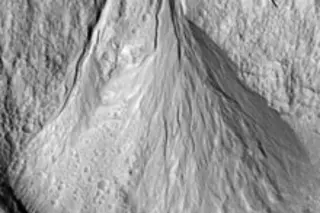Water may have been flowing over the surface of Mars as recently as 1.25 million years ago, according to a new study that examined gullies and fan-shaped deposits on the Martian landscape and determined that they were formed by melting ice. There probably wasn't much water, explains lead researcher Samuel Schon:
"You never end up with a pond that you can put goldfish in.... But you have transient melt water. You had ice that typically sublimates. But in these instances it melted, transported, and deposited sediment in the fan. It didn't last long, but it happened" [BBC News].
NASA's Mars Reconnaissance Orbiter was able to distinguish
evidence of water-borne sediments being carried down from high ground and deposited in low-lying alluvial fans [Telegraph].
While previous research had raised the possibility that Martian gullies were carved by avalanches of sand, the sharp new images discredit the theory of
drifting sands, and ...














